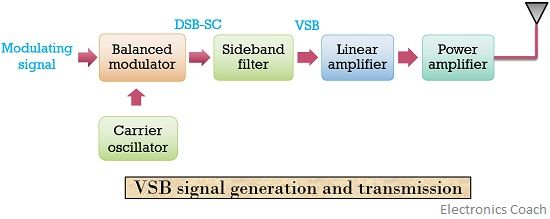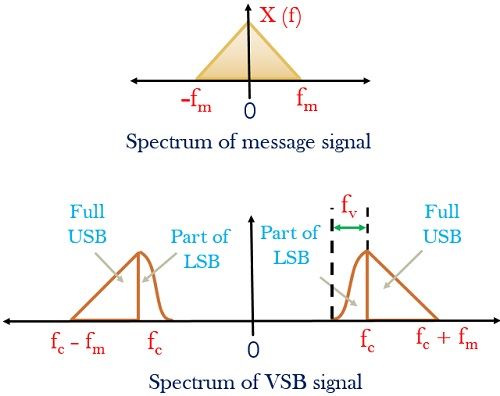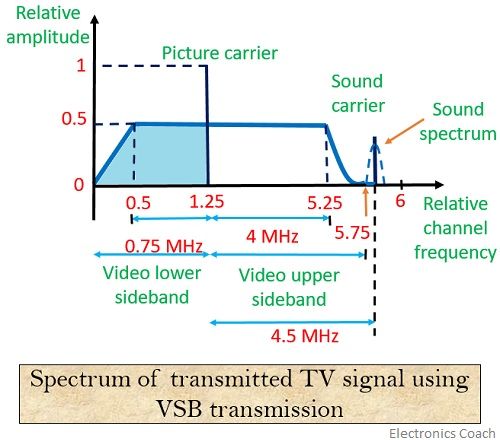Definition: Vestigial Sideband (VSB) modulation is a modulation technique which allows transmission of one sideband in addition with a part or vestige of the other. It is basically a compromise between DSB-SC and SSB modulation.
VSB technique was introduced to overcome the drawbacks of SSB modulation. As SSB modulation requires accurate frequency response of the filter to transmit only one sideband completely.
Thus by using VSB modulation one can simplify the design of the filter to a great extent. Also, the SSB modulation does not allow transmission of extremely low-frequency signal accurately. Hence VSB technique is used.
Usually, VSB technique is used in TV transmission as television signal are extremely low-frequency signals.
Generation of Vestigial sideband (VSB) modulated wave
Let’s now have a look at the figure shown below for the generation and transmission of Vestigial sideband signal:

Here, from the above figure, it is clear that a VSB signal is generated at the output of the sideband filter employed in the circuit. However, further amplification of the signal is needed in order to transmit it to longer distances.
The balanced modulator used here produces the DSB-SC signal which is fed to the sideband filter. The filter is designed such that it transmits one sideband including vestige (some part) of the other.
Thus producing a VSB signal.
Description of frequency domain
Let’s have a look at the spectrum of the message signal and VSB signal

It is already clear that in vestigial sideband modulation some eliminated portion of USB is compensated by the vestige of LSB.
The bandwidth of the Vestigial sideband signal is given by
BW = fm + fv
Performance comparison of Vestigial sideband (VSB) modulation with DSB-SC and SSB modulation
We are already aware of the fact that an amplitude modulated signal consists of two sidebands along with a carrier.
However, systems utilizing suppression of the signal eliminates sometimes carrier only and sometimes one sideband along with the carrier. Due to this, there exist some comparison points between them.
- A system utilizing a conventional amplitude modulation technique increases both power consumption and bandwidth. However, DSB-SC and SSB systems reduce the power consumption. Among all VSB system is best when it comes to bandwidth utilization.
- In case of DSB-SC and SSB modulation techniques, the filter must be highly efficient in order to suppress the carrier and desired sideband. On contrary, VSB does not need such accurate filtering characteristics.
- The conventional method of amplitude modulation provides simple demodulation at the receiver end. However, the detection process of DSB-SC, SSB, VSB signals is costly and difficult. Hence for broadcasting purposes, the conventional technique is mostly used.
Advantages of Vestigial sideband (VSB) modulation
- It is a highly efficient modulation technique used for wave transmission.
- It reduces the bandwidth utilization.
- The filter characteristics do not need to be highly accurate thus making its design simple.
- It easily transmits low-frequency components and possesses good phase characteristics.
Disadvantages of Vestigial sideband (VSB) modulation
- Its bandwidth requirement is somewhat higher than that of SSB modulation, due to the presence of vestige.
- Vestigial sideband modulation leads to a complex demodulation process at the receiver end.
Application of Vestigial sideband (VSB) modulation
For the transmission of television signals, VSB technique is widely used. As during transmission of TV signals, there is a need of simultaneous transmission of both audio and video information.
Since a bandwidth of video signal is 4.2 MHz and we have already discussed in DSB-SC modulation that it requires bandwidth twice that of the message signal. Hence in case of DSB system, the required bandwidth will become 8.4 MHz i.e., twice the bandwidth of the video signal.
Furthermore, by inserting guard band between audio and video carriers then it leads to some more increase in channel bandwidth and causes it to reach up to 9MHz.
Such a large bandwidth must be reduced and so VSB technique is adopted.
Here, we can see the spectrum of transmission of TV signal using VSB technique in the figure shown below

VSB technique allows the transmission of the upper sideband along with the vestige of lower sideband. However, suppresses the remaining part.
From 1.25 MHz of lower sideband band, 0.75 MHz vestige is transmitted and rest is suppressed. This basically simplifies the filtering requirements.
Hence, by this, we can reduce the bandwidth requirement to 6 MHz from 9MHz.
Leave a Reply